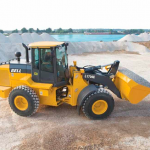The loader is one very effective and useful construction machine which can be found at every construction site. It is used in many various industry sectors like: construction, forestry, landscaping, mining, agriculture, etc. Maximizing the productivity, profitability and the efficiency level with the loader starts by choosing the most suitable loader configuration depending on the application. Generally, the loader manufacturers offer two different loader linkage options: parallel lift linkage configuration and the Z-bar linkage configuration. The parallel lift linkage is also known as a tool carrier. The nature of the job affects the selection of the linkage configuration. If the main function of the loader is to load and unload materials by using the fork attachment, then a parallel lift linkage configuration will be the proper choice. On the other hand, a loader with a Z-bar linkage configuration will manage tasks that require great digging power.

Better Breakout Force
Each linkage configuration option has own advantages and disadvantages. The Z-bar linkage configuration is the most common linkage option found in almost every loader. It has been in use since the invention of the loader. The name of this linkage configuration comes from the Z shape of the tilt cylinder, link and level layout. The Z-bar has minimum pins, links and levers that need to be maintained. This particular linkage is generally used with a bucket loader attachment. The breakout force is the biggest advantage of the Z-bar linkage configuration and loaders designed with such linkage have the ability to produce higher breakout force. Also, these loaders have the ability to manage high torque in a lower lift arm position. This way, the loader produces higher breakout force and is the ideal machine for loading tasks. The Z-bar linkage configuration however has visibility constrains when it is used with certain loader attachments. The operator’s visibility is greatly reduced because the hydraulic cylinder is placed in front of the operator field of vision. The Z-bar linkage also has another disadvantage because it tends to roll back when it is raised. Because of this, the job of the operator to maintain stability can be a real challenge.
Increased Visibility And Stability
The visibility is the biggest advantage that is provided by the parallel lift linkage configuration. With this linkage option, the loader operator has far better visibility when operating and driving the loader. The links are placed directly above the lift arms, instead of between them, what increases the visibility level. The parallel lift capability is another big benefit provided by this linkage configuration. This linkage option enables the front attachments of the wheel loader to remain parallel when raised in the air. The parallel lift configuration is generally suitable for applications that require usage of forks, grapples and other similar attachments. The parallel lift linkage is available in different designs, but generally it is far more complex linkage configuration than the Z-bar linkages as it features more cylinders, pins, levers and links. Typically, parallel lift linkages have been designed mainly with two sets of linkages and two hydraulic cylinders. Because of this, there are twice as many parts that need to be regularly serviced and maintained when compared with the single cylinder and linkage set of the Z-bar linkage design. The less efficient breakout force is another disadvantage of the parallel lift linkage. The parallel lift linkages can be found in many compact and mid-sized loader machines where the need for high visibility and precision outweigh the need for higher breakout force.


